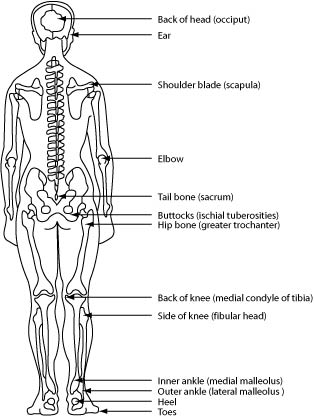Where should skin integrity observation and care strategies be used?

A methodical review and documentation of skin surfaces is important to distinguish between normal and abnormal skin behaviour. It includes checking for skin:
- colour
- response to temperature
- areas of hardness
- blanching or non-blanching
- oedema.
Use the figure on the left to refresh your memory of common pressure areas. Remember that some residents will have body areas subject to pressure because of the way they move, equipment they use and their individual body features.
When should skin assessments and care strategies be put in place?
Skin inspections should be conducted regularly to ensure that residents' skin integrity is good. The frequency of inspections should be determined by the resident’s health and wellbeing, for example, existing illnesses, mobility and nutrition.
![]() How frequently do you check your skin? What changes do you notice in your skin if
How frequently do you check your skin? What changes do you notice in your skin if
you are feeling unwell, for example, have a cold? What changes do you notice in your skin if you haven’t been drinking enough water? What care strategies do you put in place if your skin isn’t as well as it should be?
Click on the Next button to continue.